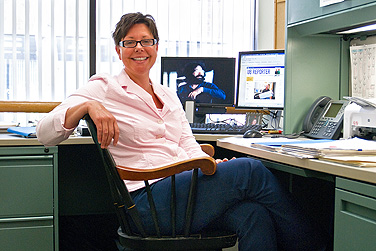Close Up
UB key to Elizabeth Stone’s story

Elizabeth Stone was a key player in moving the mammoth University Course Catalog into the new UB Student Information System. Photo: JIM ULRICH
-
 Print
Print -
 Comments
Comments
-
“I’ve always liked process, but these jobs gave me real-life experience into problem-solving at all institutional levels.”
Everyone has a story, and Elizabeth Stone is no exception. Hers includes postcolonial literature, Capen Hall and a touch of seasickness.
Stone is a senior staff member in Student Academic Records and Financial Services (SARFS), part of Academic Processing Services (APS, or central scheduling). Born and raised in Buffalo, she received a BA in history from the University of Utah. She returned to Western New York and worked for several years in mortgage banking before finishing a BA in French at UB.
After taking a job as assistant managing editor of the UB Law School’s Law and Policy journal, Stone discovered that UB was a supportive, engaging place to make a new start.
She also continued her academic career at UB. After earning a master’s in humanities, she decided to pursue a PhD program in comparative literature. “I had helpful conversations with some UB faculty and realized that my love of Francophone literature and language could be fulfilled by comp lit,” she says.
Stone began her doctoral degree program in comparative literature in 2000 and has been steadily working on it while moving through several positions in student services and administration.
In 2004, Stone moved to the Office of the Provost as assistant to the vice provost for academic affairs and then worked for Beth Del Genio, Provost Satish K. Tripathi’s chief of staff, a year later. It was in the heart of student administration in Capen Hall—where she wrote communications and processed student petitions, and then dealt with students and parents at the Student Response Center—that Stone says she began to fully grasp the complex web of offices, units, staff and faculty dedicated to helping students through their college years. She says she also developed skills in computer database and personnel management while serving as personnel coordinator for SARFS.
“I’ve always liked process, but these jobs gave me real-life experience into problem-solving at all institutional levels,” she notes.
Since the UB 2020 transformation projects began, Stone has been heavily involved in the Student Services Transformation (SST) project, a campus-wide initiative to migrate all student-related services on campus to a single electronic system.
Stone believes that her most fulfilling moments at UB also have been the most challenging. While she was the communication coordinator for the SST project, she and the SST consultant pulled long hours and expended “a lot of blood, sweat and tears” to create the project’s communications plan and coordinate its readiness assessment—thorough documentation of how the project would function at launch. She also was a key player in launching SST’s first major success: moving the mammoth University Course Catalog into the new UB Student Information System (UBSIS). The full schedule is slated to “go live” in August after months of intense user testing and staff training, all of which Stone managed as part of the Student Records team.
When she’s not working in the SST project hub office in Millard Fillmore Academic Center in the Ellicott Complex, Stone can be found nearby in Porter Hall, overseeing a small staff responsible for processing UB’s course schedules and student transcripts.
One of Stone’s happiest discoveries has been how her work overlaps with her scholarship, which focused on West African oral traditions and the social realism of South African novelist Nadine Gordimer. “I spend my time in APS and SST looking for learning gaps, making revisions and understanding interdependencies, which is essentially what comparative literature looks for across languages and cultures,” she says. “Everything we do creates narrative—a story with a beginning, middle and end.”
As for the seasickness, that chapter began early on. Her large family grew up together on the high seas, in an ocean-going wooden boat her father rebuilt and began chartering. The problem was her stomach; Stone fell ill whenever she set sail. “I ended up not going on the longer trips they took to South America and even Europe, but there are lots of great memories of our trips to the West Indies,” she says. “There are multitudes of stories wrapped up in travel, and I loved the newness of it all: the smells, the tastes and all of the new things you’d see at each port of call.”
Now remarried and living in Williamsville, Stone still travels extensively when she’s not relaxing at home with her husband, children and their dog, Daisy. Last year, after years away from the water, she traveled to Hungary, her father’s homeland, where she visited Budapest and sailed on Lake Balaton. She is on a break from the PhD program with all but her dissertation left to complete, but her plan is to one day finish up and close that chapter. “I’m looking forward to what my life—this story—has planned for me,” she says.

Reader Comments